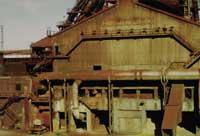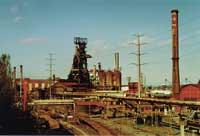Are we able to harmonize the environment with industry?
Introduction to environmental management
At first it was thought that the medium was almost unalterable and that the resources were almost inexhaustible; that the capacity of air, water and land to collect, disperse or purify the waste had no limits.

In the 70s and 80s a series of accidents occurred with serious environmental impacts: Seveso, Basel, Exxon-Valdez, Txernobil… By then society was aware of the influence that industry has on humans and the environment and, since then, the pressure of society itself has led companies to take charge of the damage produced in this activity.
Due to the significant economic loss of these accidents, insurance companies have also asked their customers for stricter prevention and control measures and must demonstrate that all measures to reduce policies are currently being met. These have been the main reasons that have driven environmental certification.
The current entrepreneurs, therefore, have knowledge of the environment and is gradually being integrated into the management plans of the companies, with prevention as main objective. For example, the company Sandoz —1986. In 2012, the main culprit of the Basel accident has subsidized studies on water quality and river status to improve its image and allocates 16% of its investments to improve safety and reduce environmental impacts.
Company environment: audits and environmental management systems
If you want to take into account the environment in companies, you can opt for different ways of working depending on the objective and how far you want to reach. In general, there are two main ways: audits and environmental management systems.
Audits
are basically concrete studies, which are carried out with a concrete and concrete purpose and that start and finish. The audits conclude with a detailed description of the situation of the company, that is, how and to what extent the pollution that is generated, if it complies with the legislation, if it uses the appropriate technology, etc.
Depending on the objective you want to accomplish, there are different types of inspections, some of the most frequent being the following:
- Audit prior to the implementation of an environmental management system that allows us to analyze the environmental situation of the company.
- Waste reduction oriented inspection.
- Once the environmental management system is implemented, the audit is carried out to know if it is going well or not and, if applicable, to introduce improvements.

Environmental Management Systems
The integration of the environment in the management plans of the company. This means that the environment is not worked separately and is taken into account in all areas and activities of the company, as well as production itself or technological innovation. Therefore, these systems aim to achieve a commitment to continuous environmental improvement with increasingly demanding objectives.
Regarding environmental management systems, the main sections that are addressed are:
- Initial analysis and diagnosis or initial audit. Once all environmental legislation has been compiled and its compliance has been analyzed, a report is prepared.
- Basic documentation for the system. According to the results of the initial audit, the Heads of Companies establish the environmental policy and set the objectives to be achieved with this system. In this section, a program and an environmental management manual are prepared.
- System-specific documentation. Once all the processes are defined, the procedures are explained in detail, ensuring in writing that all of them are carried out in the manner indicated above.
- Implementation of an environmental management system.
- Verification of the implemented system: internal audit.
- Certificate and VºBº issued by the competent entity (Aenor or equivalent entity).
How to regulate?
This concept of environmental management has been developed in the industrial field. Industrial associations defend the theory that industry itself has technology and experience to properly manage the environment. They believe that the market will be the driving force behind environmental management systems, that is, that responsible consumption with the environment chooses the least environmentally harmful product. Thus, market forces would replace the laws imposed by governments and it would be enough to establish rules that set the way.
However, those who oppose this theory claim that, because of the forces that have a great influence on society (advertising), that theory defended by industrial associations is hardly achievable.
On the other hand, environmental groups consider that environmental protection cannot be left in private hands because their main interests are economic. It should be borne in mind that the strength of the industrial associations was decisive in order that the 1836/93 or ecomanagement and audit regulations were not complied with and that the participation of workers in the company's environmental policy should not be channeled.
Regulations and regulations
The first regulation dealing with the relationship between companies and the environment is 1836/93 on the EMAS or community system of ecomanagement and audit. The work to reach this regulation began in 1990 taking into account the opinions of experts and industrial associations. The Regulation was approved by the Ministers of Environment of the European Union on 23 March 1993 and published the same year.
This regulation allows companies, on a voluntary and unforced basis, to integrate into the Community system of environmental management and auditing.
In addition, most countries have developed environmental regulations, such as the IS 3310 in Ireland, the BS 7750 (British Standard) in the UK and the UNE-77801 in Spain, which regulates environmental management systems and the UNE-77802, which oversees the control of these systems.

These standards are developed by different organizations such as AENOR (Spanish Association of Standardization) in Spain, CEN (European Standardization Committee) and ISO (International Standards Organization) worldwide.
The latter entity published in 1996 the Environmental Management System Standard, ISO 14001, with which the standards of most countries have been unified, being the most used currently. In Spain, for example, UNE-EN ISO 14001, formerly UNE-77801, is currently in force. For your understanding, ISO 14001 is equivalent to ISO 9000 quality standard. There are very similar sections and ways of working.
Therefore, Regulation 1836/93 (EMAS) and ISO 14001 standards are currently the main guidelines for the implementation and certification of an environmental management system.
The main difference between the two is: Once the certification has been obtained under Regulation 1836/93, the public declaration will be made, which must also obtain the approval for the name of the company to appear in the Official Journal of the European Union.
Environment and industry today
Until May 1996, Regulation 1836/93/EEC had registered 829 companies throughout Europe. In the case of the Basque Country, 8 companies have obtained the certification of their environmental management system according to ISO 14001, seven of them by the hand of AENOR and one of the company Lloyd’s Register. However, there are other companies under certification.
From our experience, the audit carried out in a foundry that works the grey cast, we will analyze the current situation in the following lines. And is that in our territory there are a large number of companies of this type that had a great success in the past, that have not renewed at any time their infrastructure.
The analyzed casting consists of four main processes:
- Melting metal: the paw melts into an oven called a cubilote.
- Preparation of sand molds: the sand is compressed and converted into a rigid mold, the molten metal is deposited inside and when cooled it proceeds to the separation of the part and the mold. The sand used in the mould making is reused.
- Manufacture of handles or sanders: to make the holes inside the piece, the mold needs mangoes called males. The males are not compatible with the mold, they are manufactured elsewhere in the factory and can be manufactured by five processes depending on the catalysts used.
- Polished and painted parts.
Once these processes are analyzed, the cubilote is one of the main problems we have encountered. This type of furnace works through combustion, generating large amounts of CO2, SH2 and metal particles. The most used system for cleaning these gases that are formed, since it is the cheapest, is precipitation with water, but the volume of sludge that is generated is huge. In addition, mud can be toxic due to its high concentration of metals. The correct solution consists, on the one hand, in replacing the combustion furnace with the electric furnace and, on the other, in replacing the purification with water by dry purification.
On the other hand, the use of sand in the manufacture of the molds implies the release of large quantities of particles during the process; in the case we have studied, the absorption and filtering systems were inadequate or were not properly placed.
The sand for the manufacture of males needs a reuse treatment and, having five processes, many other treatments are needed. To do this the infrastructure is very expensive and in practice it is cheaper to throw sand together with waste than to reuse it. The only solution is to reach an agreement between companies and a sand recycling infrastructure, which would also serve to reduce the amount of waste.

On the other hand, the collection of raw materials and waste is a basic problem. In fact, inside the factory, on a plot, they accumulate without any protection, depending on rain or wind.
In addition, the lack of precision of the procedures causes occasional work accidents or improper handling, which causes the dispersion of odors and particles in the environment. The measures that have been proposed to avoid these problems are costly and, despite having subsidies for this, the economic situation of most companies prevents them from facing these measures and environmental management is out of their plan.
As for the Administration, it wants to promote environmental management plans, but it can not affect too much in companies with economic problems, since in some cases it would be necessary to close companies leaving workers on the street.
A report addressed to the Basque Government by the association of foundries indicates that 600 million pesetas would be needed to reduce the number of particles generated by the cubilotes and 2.8 billion pesetas to prepare sand reuse processes.
One way to deal with the investment required by environmental management would be to add this cost to the final price of the product. This requires a high degree of social awareness that allows them to be willing to pay for this price difference, although this implies a decrease in consumption capacity.
Reasons for and against the audit or implementation of EMSPros:
Unfavorable:
|





